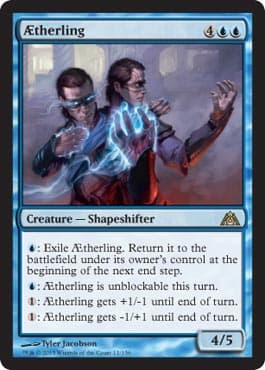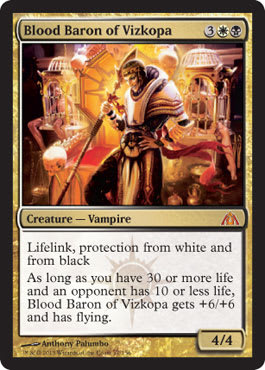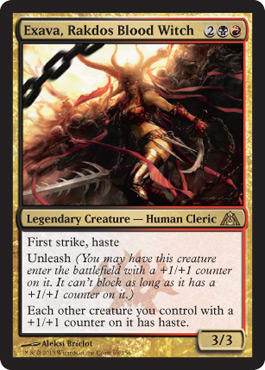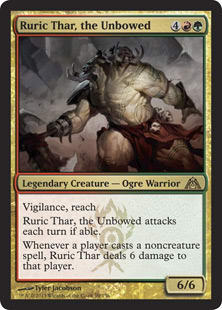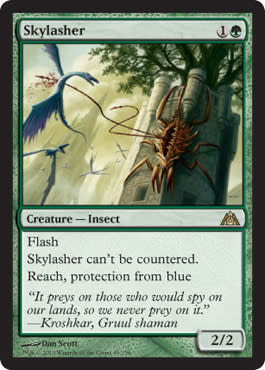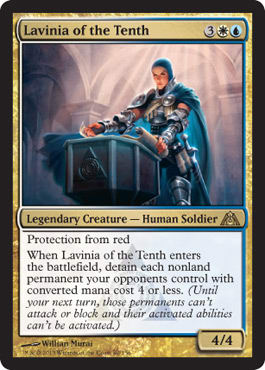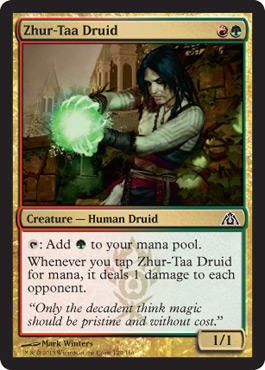What makes a creature playable in Standard? Which creatures from Dragon’s Maze are worthy of consideration based on the metagame? If you are interested in the answer to either or both of these questions, welcome to the Dragon’s Maze Playable Creature Set Review!
I analyzed the creatures that appeared in 5% or more of the Top 16 decks since rotation, fifty-one cards in total. These cards represent 90% of the total creatures played and share some characteristics. I grouped these characteristics into three different profiles of playable creatures and used them to evaluate the creatures of Dragon’s Maze. In this article, I’ll provide an overview of these characteristics and profiles, and I’ll review the creatures that best match them to determine what creatures are most likely to see play.
Creature Characteristics

Remember the Titans? Well, they’re long gone, and Standard has downsized. 4 mana is the new 6, and unless Dragon’s Maze changes the landscape dramatically, not many creatures that cost more than 5 will see play.

Most of today’s decks win via combat damage, and playing the most powerful creatures at each spot on your mana curve supports this strategy. As a means of comparing creatures at different costs, I used a power-to-cost ratio (power divided by converted mana cost). As you can see, most creatures that see significant play are a 1, which means they are a 2/2 for 2 CMC, 3/3 for 3 CMC, and so on.
A high power-to-cost ratio is not enough to guarantee play. Vexing Devil has the highest in Standard and has been included in only a couple Top 16 decks. Dryad Militant and War Falcon have seen more play but did not make the most-played list. Slumbering Dragon, Treacherous Pit-Dweller, and Faerie Impostor all have high ratios but come with significant drawbacks that make them unlikely to see much competitive play.
A lower ratio does not mean a card won’t see play either: Blood Artist and Izzet Staticaster have 0 power but make up for it with impactful abilities. The better a card’s abilities, the less important power becomes.
 |
 |
 |
 |
 |
Having multiple abilities on a card is also no guarantee a creature will see significant play. There are thirty-eight creatures with three or more abilities, but only eleven are on our most-played list. Eight more have seen play in a few decks—cards such as Griselbrand, Elite Inquisitor, and Predator Ooze—but that leaves nineteen, exactly half, that have seen no play at all.
Eight of those cost 6 or more mana and are therefore a tough sell in today’s metagame. Seven more have power-to-cost ratios below .7 and don’t possess abilities that sufficiently make up for it. Falkenrath Marauders and Hollowhenge Spirit are prime examples. Many cards, such as Stuffy Doll, have multiple abilities but with questionable value in Standard. Cards like Spark Trooper have strong abilities but also large and obvious drawbacks that will limit play.

Some cards fail to see play not because of insufficient power or abilities, but due to competition. Vorapede is powerful but is hard to justify versus format heavyweight Thragtusk. Hypersonic Dragon has to fight for a place over Thundermaw Hellkite with a questionably useful third ability. Truefire Paladin faces no shortage of aggressive 2-drops, including Ash Zealot and Burning-Tree Emissary.
Here are the top competitors by color and cost:

Dragon’s Maze is a smaller third set that expands on the existing themes of the block. It could have a major impact on the metagame, but that is less likely than with a larger fall set chock-full of new mechanics. It is more likely that the top decks will remain on top, with one or two new ideas being added to the mix.
Jund Midrange and Junk Reanimator are the top decks of the current metagame. Esper Control is also strong, but it does not play many creatures. There are a host of other aggressive red-based decks in the mix as well. To see significant play, new cards will either have to fit into these existing archetypes or be strong enough to help forge a new one.
Playable Creature Profiles
Now we’ll go into the types of creatures that see the most play. 91% percent of the most-played creatures fit into one of these three profiles.
 |
 |
 |
Dragon’s Maze Creatures
We’ve now come to Act III of the article: the candidates. I’m not going to go through every creature of the set—just the ones that match one of the profiles outlined above. These are the cards most likely to see play in the current metagame.

Aetherling
Note: This creature is a bit expensive to fit the profile, but it’s still worth a review.
The Good:
Four activated abilities make Aetherling the Swiss army knife of creatures. It can be an unblockable 8/1 attacker, a stalwart 0/9 Wall defender, and anything in between. It is very difficult to remove it from the battlefield thanks to its self-exiling ability. Given enough time and mana, this creature will win a game. You will get out of it what you are willing and able to put in.
The Bad:
Aetherling costs 6 to cast and requires a continual mana investment to make good, and it requires a significant mana investment to make it decisive. An opponent can force you to temporarily remove it from play prior to attacking, eliminating it as a blocker.
The Verdict:
Despite its cost, Aetherling is likely to see play as a resilient blocker and threat for control decks. At a minimum, it will make control sideboards for use in mirror matches.
Blood Baron of Vizkopa
The Good:
Protection from white and from black is outstanding and invalidates a lot of removal; 4 toughness takes care of a lot of the rest. 4 power and lifelink make the Baron a significant blocker and stabilizer in this aggressive format. He cannot be blocked by 55% of the most-played creatures, including Angel of Serenity, Boros Reckoner, Centaur Healer, and Restoration Angel. Lingering Souls tokens cannot chump-block, and Olivia Voldaren cannot recruit this Vampire.
The Bad:
“As long as you have 30 or more life and an opponent has 10 or less life, Blood Baron of Vizkopa gets +6/+6 and has flying” is an ability isn’t particularly relevant in Standard. If you meet both requirements, you are already winning handily. It doesn’t add much to the card.
The Blood Baron costs 5 and is not likely to close out games unless your opponent has only white and black blockers. Obzedat, Ghost Council shares a cost and colors and is a more aggressive card that will compete for play time.
The Verdict:
The Blood Baron is playable as a stabilizer, board staller, and occasional damage source for Esper Control, at least out of the sideboard against aggressive decks.
Exava, Rakdos Blood Witch
The Good:
A 4/4 first striker with haste for 4 mana is very aggressive, and not being able to block is a minor drawback in the right deck. It will be difficult to block and kill Exava in combat, and keeping her “leashed” can help deal with Thragtusk and its token.
The Bad:
“Each other creature you control with a +1/+1 counter on it has haste” is an ability that’s not particularly useful. Sure, your top-decked Rakdos Cackler now has haste, but how impressive is that on turn five or later? Exava is also a legendary creature, so having multiple copies in hand is suboptimal.
Exava, Rakdos Blood Witch’s biggest problem is competition. She runs up against Hellrider and Falkenrath Aristocrat as curve-toppers for black and red aggressive decks and against Olivia Voldaren in Jund Midrange. Those cards all have reach or evasion and can take over a game.
The Verdict:
Not bad, but not good enough against the competition.
Ruric Thar, the Unbowed
Note: Again, 6 CMC does not match the criteria of the profile, but Ruric Thar is an interesting enough card to warrant review.
The Good:
The Gruul champion has three abilities and a cost-to-power ratio of 1, and attacking each turn isn’t much of a drawback given his size and vigilance. Only a couple creatures in Standard can block him one-on-one, but he can block almost anything and survive. His triggered ability ensures that if he resolves, he is doing at least 6 damage unless he is removed in combat or chump-blocked indefinitely. There is certainly the potential to do much more against control or tempo decks.
The Bad:
Ruric Thar costs 6 mana, which is a lot in the current metagame. His hatred of noncreature spells, regardless of who casts them, means he is best-suited for a creature-heavy deck. Jund and Naya Midrange decks play too many spells to make him work, and he is far too expensive to fit in any of the fast creature aggro decks in the current metagame.
The Verdict:
Ruric Thar lacks a clear home now, but if things slow down or if control becomes dominant, Ruric Thar, the Unbowed could see some play in Naya or Jund Midrange sideboards. He may also be good enough to inspire some new ramp concepts.
Skylasher
The Good:
Four static abilities and a power-to-cost ratio of 1 make this Insect worth some consideration. Skylasher’s biggest value is against blue-based control and tempo decks that rely on chump-blocking with Snapcaster Mage or Augur of Bolas in the early game. Bypassing those blockers could be worth 2 to 4 damage. This Insect is also a good surprise blocker against Geist of Saint Traft.
The Bad:
Skylasher is an anti-blue hate bear in a format that doesn’t really need one. Control players are probably not using a counter on Skylasher, and protection from blue really only helps against Azorius Charm, Izzet Charm, Detention Sphere, and the aforementioned trio of creatures. It is still swept away by Supreme Verdict on turn four just like most other creatures.
The Verdict:
This card would have been great against the Delver of Secrets decks pre-rotation, but that doesn’t matter much in Standard right now. It could see play in aggro sideboards that need help finishing off games against control or tempo opponents—or for handling Geist of Saint Traft.

Lavinia of the Tenth
The Good:
The enters-the-battlefield detain ability will be great for slowing down aggro decks and for getting a free hit in. Lavinia of the Tenth works extremely well with Restoration Angel and can be played in the late game to set up a lethal attack. Protection from red means Lavinia need not worry about an overloaded Mizzium Mortars, a Bonfire of the Damned, a morbid Brimstone Volley, or a Blasphemous Act. She is also a great blocker against Boros Reckoner, Ravager of the Fells, and many other red creatures.
The Bad:
Esper Control, and often Bant Control, will prefer to play Supreme Verdict on turn four. The detain effect is best with a board presence that can attack the turn she is played, reducing the effectiveness for control decks. She also doesn’t do much to mitigate Thragtusk, Angel of Serenity, Thundermaw Hellkite, or Falkenrath Aristocrat the turn it is played. Lavinia will compete with Thragtusk in Bant decks and Obzedat, Ghost Council in Esper.
The Verdict:
Lavinia of the Tenth will find a home in Bant Control or Midrange sideboards and see play against Naya Blitz, GR Aggro, Jund Aggro, and other aggressive decks.
Zhur-Taa Druid
The Good:
Simultaneous mana production and direct damage to an opponent is a strong pair of abilities. Like most 2-drops, Zhur-Taa Druid works very well with Burning-Tree Emissary. It is also a Human, which is relevant right now.
The Bad:
Ramp decks will prefer 1-mana dorks over this card. ![]()
![]() on turn two will be problematic sometimes as well. As a 2-mana accelerant, it has some competition. Gyre Sage has the potential to produce more mana and evolve into a reasonable attacker. Farseek can fetch a shock land. Aggressive decks have better and faster options at 2 mana. The incremental damage is unlikely to be enough to offset this.
on turn two will be problematic sometimes as well. As a 2-mana accelerant, it has some competition. Gyre Sage has the potential to produce more mana and evolve into a reasonable attacker. Farseek can fetch a shock land. Aggressive decks have better and faster options at 2 mana. The incremental damage is unlikely to be enough to offset this.
The Verdict:
Zhur-Taa Druid will see play, but it will take some experimentation to find the right home. More than likely, it will be in a Jund or Naya Midrange deck, where it can help accelerate out a Thragtusk and deal incremental damage over a longer game.

Blood Scrivener
The Good:
Card-draw for an aggressive deck when needed most: in top deck mode or after a board wipe. Blood Scrivener is easy to cast and is a Zombie.
The Bad:
It competes with Lotleth Troll and Blood Artist in Zombie decks, but it could work well with either.
The Verdict:
Blood Scrivener will see play in the Zombie archetype. You know they’ll be back, right?
Closing
That concludes my Dragon’s Maze creature set review. I hope you found it interesting, educational, and at a minimum entertaining. Join me next week as I analyze SCG Open: New Jersey, the first major tournament with Dragon’s Maze in Standard. Thanks for reading!
Nick Vigabool













